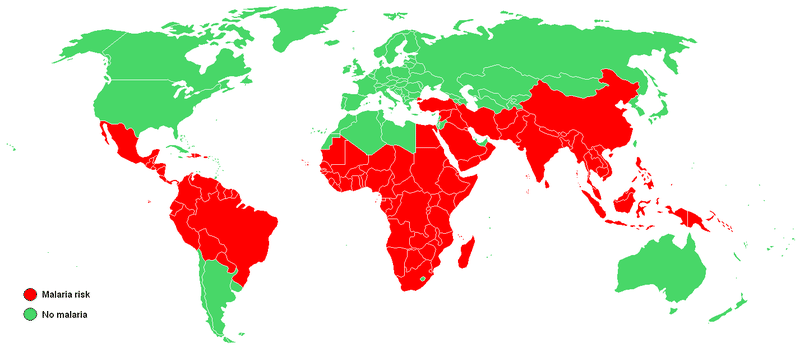8.14: Protists and Disease
- Page ID
- 12200
\( \newcommand{\vecs}[1]{\overset { \scriptstyle \rightharpoonup} {\mathbf{#1}} } \)
\( \newcommand{\vecd}[1]{\overset{-\!-\!\rightharpoonup}{\vphantom{a}\smash {#1}}} \)
\( \newcommand{\dsum}{\displaystyle\sum\limits} \)
\( \newcommand{\dint}{\displaystyle\int\limits} \)
\( \newcommand{\dlim}{\displaystyle\lim\limits} \)
\( \newcommand{\id}{\mathrm{id}}\) \( \newcommand{\Span}{\mathrm{span}}\)
( \newcommand{\kernel}{\mathrm{null}\,}\) \( \newcommand{\range}{\mathrm{range}\,}\)
\( \newcommand{\RealPart}{\mathrm{Re}}\) \( \newcommand{\ImaginaryPart}{\mathrm{Im}}\)
\( \newcommand{\Argument}{\mathrm{Arg}}\) \( \newcommand{\norm}[1]{\| #1 \|}\)
\( \newcommand{\inner}[2]{\langle #1, #2 \rangle}\)
\( \newcommand{\Span}{\mathrm{span}}\)
\( \newcommand{\id}{\mathrm{id}}\)
\( \newcommand{\Span}{\mathrm{span}}\)
\( \newcommand{\kernel}{\mathrm{null}\,}\)
\( \newcommand{\range}{\mathrm{range}\,}\)
\( \newcommand{\RealPart}{\mathrm{Re}}\)
\( \newcommand{\ImaginaryPart}{\mathrm{Im}}\)
\( \newcommand{\Argument}{\mathrm{Arg}}\)
\( \newcommand{\norm}[1]{\| #1 \|}\)
\( \newcommand{\inner}[2]{\langle #1, #2 \rangle}\)
\( \newcommand{\Span}{\mathrm{span}}\) \( \newcommand{\AA}{\unicode[.8,0]{x212B}}\)
\( \newcommand{\vectorA}[1]{\vec{#1}} % arrow\)
\( \newcommand{\vectorAt}[1]{\vec{\text{#1}}} % arrow\)
\( \newcommand{\vectorB}[1]{\overset { \scriptstyle \rightharpoonup} {\mathbf{#1}} } \)
\( \newcommand{\vectorC}[1]{\textbf{#1}} \)
\( \newcommand{\vectorD}[1]{\overrightarrow{#1}} \)
\( \newcommand{\vectorDt}[1]{\overrightarrow{\text{#1}}} \)
\( \newcommand{\vectE}[1]{\overset{-\!-\!\rightharpoonup}{\vphantom{a}\smash{\mathbf {#1}}}} \)
\( \newcommand{\vecs}[1]{\overset { \scriptstyle \rightharpoonup} {\mathbf{#1}} } \)
\(\newcommand{\longvect}{\overrightarrow}\)
\( \newcommand{\vecd}[1]{\overset{-\!-\!\rightharpoonup}{\vphantom{a}\smash {#1}}} \)
\(\newcommand{\avec}{\mathbf a}\) \(\newcommand{\bvec}{\mathbf b}\) \(\newcommand{\cvec}{\mathbf c}\) \(\newcommand{\dvec}{\mathbf d}\) \(\newcommand{\dtil}{\widetilde{\mathbf d}}\) \(\newcommand{\evec}{\mathbf e}\) \(\newcommand{\fvec}{\mathbf f}\) \(\newcommand{\nvec}{\mathbf n}\) \(\newcommand{\pvec}{\mathbf p}\) \(\newcommand{\qvec}{\mathbf q}\) \(\newcommand{\svec}{\mathbf s}\) \(\newcommand{\tvec}{\mathbf t}\) \(\newcommand{\uvec}{\mathbf u}\) \(\newcommand{\vvec}{\mathbf v}\) \(\newcommand{\wvec}{\mathbf w}\) \(\newcommand{\xvec}{\mathbf x}\) \(\newcommand{\yvec}{\mathbf y}\) \(\newcommand{\zvec}{\mathbf z}\) \(\newcommand{\rvec}{\mathbf r}\) \(\newcommand{\mvec}{\mathbf m}\) \(\newcommand{\zerovec}{\mathbf 0}\) \(\newcommand{\onevec}{\mathbf 1}\) \(\newcommand{\real}{\mathbb R}\) \(\newcommand{\twovec}[2]{\left[\begin{array}{r}#1 \\ #2 \end{array}\right]}\) \(\newcommand{\ctwovec}[2]{\left[\begin{array}{c}#1 \\ #2 \end{array}\right]}\) \(\newcommand{\threevec}[3]{\left[\begin{array}{r}#1 \\ #2 \\ #3 \end{array}\right]}\) \(\newcommand{\cthreevec}[3]{\left[\begin{array}{c}#1 \\ #2 \\ #3 \end{array}\right]}\) \(\newcommand{\fourvec}[4]{\left[\begin{array}{r}#1 \\ #2 \\ #3 \\ #4 \end{array}\right]}\) \(\newcommand{\cfourvec}[4]{\left[\begin{array}{c}#1 \\ #2 \\ #3 \\ #4 \end{array}\right]}\) \(\newcommand{\fivevec}[5]{\left[\begin{array}{r}#1 \\ #2 \\ #3 \\ #4 \\ #5 \\ \end{array}\right]}\) \(\newcommand{\cfivevec}[5]{\left[\begin{array}{c}#1 \\ #2 \\ #3 \\ #4 \\ #5 \\ \end{array}\right]}\) \(\newcommand{\mattwo}[4]{\left[\begin{array}{rr}#1 \amp #2 \\ #3 \amp #4 \\ \end{array}\right]}\) \(\newcommand{\laspan}[1]{\text{Span}\{#1\}}\) \(\newcommand{\bcal}{\cal B}\) \(\newcommand{\ccal}{\cal C}\) \(\newcommand{\scal}{\cal S}\) \(\newcommand{\wcal}{\cal W}\) \(\newcommand{\ecal}{\cal E}\) \(\newcommand{\coords}[2]{\left\{#1\right\}_{#2}}\) \(\newcommand{\gray}[1]{\color{gray}{#1}}\) \(\newcommand{\lgray}[1]{\color{lightgray}{#1}}\) \(\newcommand{\rank}{\operatorname{rank}}\) \(\newcommand{\row}{\text{Row}}\) \(\newcommand{\col}{\text{Col}}\) \(\renewcommand{\row}{\text{Row}}\) \(\newcommand{\nul}{\text{Nul}}\) \(\newcommand{\var}{\text{Var}}\) \(\newcommand{\corr}{\text{corr}}\) \(\newcommand{\len}[1]{\left|#1\right|}\) \(\newcommand{\bbar}{\overline{\bvec}}\) \(\newcommand{\bhat}{\widehat{\bvec}}\) \(\newcommand{\bperp}{\bvec^\perp}\) \(\newcommand{\xhat}{\widehat{\xvec}}\) \(\newcommand{\vhat}{\widehat{\vvec}}\) \(\newcommand{\uhat}{\widehat{\uvec}}\) \(\newcommand{\what}{\widehat{\wvec}}\) \(\newcommand{\Sighat}{\widehat{\Sigma}}\) \(\newcommand{\lt}{<}\) \(\newcommand{\gt}{>}\) \(\newcommand{\amp}{&}\) \(\definecolor{fillinmathshade}{gray}{0.9}\)
Can such little creatures make you sick?
They sure can. Not all of them, but some of them. And without proper medical treatment, the person may never recover.
Protists and Human Disease
Most protist diseases in humans are caused by animal-like protists, or protozoa. Protozoa make us sick when they become human parasites. Three examples of parasitic protozoa are described below.
Trypanosoma Protozoa
Members of the genus Trypanosoma are flagellate protozoa that cause sleeping sickness, which is common in Africa. They also cause Chagas disease, which is common in South America. The parasites are spread by insect vectors. The vector for Chagas disease is shown in Figure below. Trypanosoma parasites enter a person’s blood when the vector bites. Then they spread to other tissues and organs. The diseases may be fatal without medical treatment.
 Vector for Chagas Disease. In Chagas disease, the Trypanosoma parasite is spread by an insect commonly called the “kissing bug.” A bite from this bug could be the kiss of death.
Vector for Chagas Disease. In Chagas disease, the Trypanosoma parasite is spread by an insect commonly called the “kissing bug.” A bite from this bug could be the kiss of death.The discovery of Chagas disease is unique in the history of medicine. That’s because a single researcher—a Brazilian physician named Carlos Chagas—single-handedly identified and explained the new infectious disease. In the early 1900s, Chagas did careful lab and field studies. He determined the pathogen, vector, host, symptoms, and mode of transmission of the disease that is now named for him.
Giardia Protozoa
Giardia are flagellate protozoa that cause giardiasis. The parasites enter the body through food or water that has been contaminated by feces of infected people or animals. The protozoa attach to the lining of the host’s small intestine, where they prevent the host from fully absorbing nutrients. They may also cause diarrhea, abdominal pain, and fever. A picture of a Giardia protozoan opens this concept.
Plasmodium Protozoa
Plasmodium protozoa cause malaria. The parasites are spread by a mosquito vector. Parasites enter a host’s blood through the bite of an infected mosquito. The parasites infect the host’s red blood cells, causing symptoms such as fever, joint pain, anemia, and fatigue.
Malaria is common in tropical and subtropical climates throughout the world (see Figure below). In fact, malaria is one of the most common infectious diseases on the planet. Malaria is also a very serious disease. It kills several million people each year, most of them children. A vaccine to malaria is a possibility.
 Worldwide Distribution of Malaria. This map shows where malaria is found. The area is determined by the mosquito vector. The mosquito can live year-round only in the red-shaded areas.
Worldwide Distribution of Malaria. This map shows where malaria is found. The area is determined by the mosquito vector. The mosquito can live year-round only in the red-shaded areas.Summary
- Most protist diseases in humans are caused by protozoa. Protozoa make humans sick when they become human parasites.
- Trypanosoma protozoa cause Chagas disease and sleeping sickness.
- Giardia protozoa cause giardiasis, and Plasmodium protozoa cause malaria.
Review
- Describe how the protozoa that cause Chagas disease are spread to human hosts.
- State why malaria is commonly found only in tropical and subtropical regions of the world.
- Terri lost her water bottle while hiking in Canada. It was a hot day, so she drank water from a stream to stay hydrated. A few days later, Terri became ill with abdominal pain, fever, and diarrhea. Her doctor thinks she has a protozoan infection. Which type of protozoa do you think is most likely responsible for Terri’s illness? How do you think Terri became infected?
| Image | Reference | Attributions |
 |
[Figure 1] | Credit: Laura Guerin, William Oakley Source: CK-12 Foundation License: CC BY-NC 4.0 |
 |
[Figure 2] | Credit: Courtesy of the Centers for Disease Control and Prevention Source: http://www.cdc.gov/parasites/insects.html License: Public Domain |
 |
[Figure 3] | Credit: User:Petaholmes/Wikimedia Commons Source: commons.wikimedia.org/wiki/File:Malaria_map.PNG License: Public Domain |

